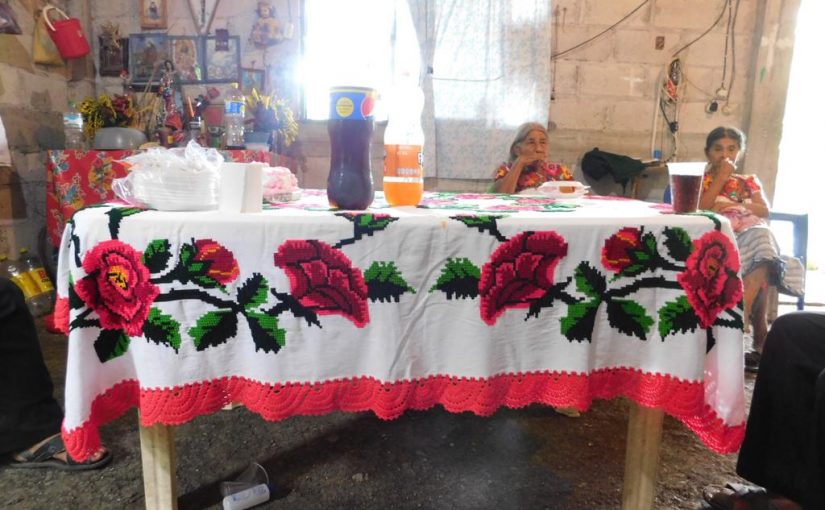In this lesson we will learn the relational terms that function like adverbs and prepositions, which indicate where, when, and how an action is done. These words and particles are used in two ways.
First, with prefixes for possessed nouns (no-, mo-, i-, to-, inmo-, inin-), as well as “tē-“, “tla-” and “ø”. For example:
no – huahca “close to me”
Second, with substantive and verbal bases, which are attached directly to the relational terms. For example:
cacal – īcān “behind the house”
Niahci āmoxcalli
Niquīza nochān, ninehnemi xitlāhuac huan niahci pan huēyi ohtli teipan nimomalacachoa īca nemahtli huan pēhua ninehnemi xitlāhuac quēnnopa niahci cāmpa eltoc ce huēyi cuahuitl. Nopayah pano tepōzcacalachtli tlen ahci nechca āmoxcalli. Nitemo inacaztlan cāmpa tlacualnāmacah teipan nitlailacatzoa īca arrebez huan niīxtlehco quēntzin huan quēnnopa niahci āmoxcalli tlen caltlamachtiloyan.
I arrive at the library
I leave my house, I walk straight and arrive at a big road. Then I turn right and begin to walk in that same way. I arrive where there is a big tree. In that place, a bus passes that arrives near the library. I get down next to where they sell food, and later I rotate left and go up a little in that way, and I arrive at the library from the school.
Tlamanēxtilli īcā motōcaxtilli tlen quipōz īteco (Example with possessive pronouns)
/-cā/ “with, unspecified location”
īcā “with this/that”
/-cuitlapan/ “over the back” (of someone)
nocuitlapan “over my back”
/-huahca/ “far from”
nohuahca “far from me”
/-huan/ “and, in the company”
mohuan “in your company”
/-huanya/ “with, in the company of”
mohuanya “with you”
/-īxtēnno/ “in front of”
noīxtēnno “in front of me”
/-tepōtzco/ “behind of”
totepōtzco “behind of us”
Tlamanēxtilli īcā tlachīhualiztli huan tlatōcaxtiliztli (Example of verbs and substantives)
/-cān/ “a place of”
Michoacān “place of fish”
/-yan/ “time or place where an action happens”
tlamāyan “in a plain field”
/-tlan/ “time an event takes place”
mancohtitlan “season of mangos”
mecohtitlan “season of festival”
icxitlan “at the feet of”
/-ihtic/ “inside of”
calihtic “inside of the house”
/-īxco/ “up, on top, over the face”
teīxco “in front of other people, in front of rocks”
/-īxpan/ “in front of, in the presence of”
calīxpan “in front of the house”
/-nechca/ “near”
nonechca “near me”
/-tech/ “next to, what belongs to”
caltech “at the edge of the house” (so it is not an obstacle)
/-tēnno/ “on the edge”
mīltēnno “at the edge of the cornfield”
/-i7cān/ “behind of”
cacalīcān “behind of the house”
/-pani/ “over, on top of”
calpani “on top of the house”
/-tzālan/ “under of”
ātzālan “under the water”
/-pan/ “on, up, on top of, long ago”
tlanempan “in a plain and clean field”
/-tzintlan/ “on the base of”
nacaztzintlan “at the base of the ear”
/-co, -c, -no/ “on, over”
tlapanico “on the roof of the house, on the top of the bank”
/-tlah/ “place characterized by abundance”
xōchihtlah “place of abundant flowers”
ācatitlan “place where there are a lot of reeds”
apachtitlan “place where there are a lot of palms”
ātēnno “at the edge of the water, river, or stream”
ātlauhco “on the stream”
ātzālan “under the water”
cacalīcān “behind the house”
calihtic “inside the house”
calmapan “on the hall of the house”
caltech “at the edge of the house (so it is not an obstacle)
caltēnno “outside of the house”
calīxpan “in front of the house”
calpani “on top of the house”
chipohtlah “place where there are a lot of ticks”
cuatēnno “on the bathroom, bank”
cuatitlan “on the bank”
ēlōhtla “season of corn”
icxitlan “at the feet of” (person, animal, or thing)
īicxitzalan “under the feet of” (person, animal, or thing)
īihtico “inside of” (person, animal, or thing)
īnacaztlan “at the side of” (person, animal, or thing)
īxcanexcān “near the house of” (someone)
īxtlan “in front of” (person, animal, or thing)
mancohtitlah “season of mango”
mecohtitlan “season of festival”
michoacān “place of fish”
mīllah “cornfield”
mīltēnno “at the edge of the cornfield”
nacaztzintlan “at the base of the ear”
nocuaīxpan “my forehead”
nohuahca “far from me”
noīcān “behind of me”
noīxpan “in front of me”
noīxtēnno “in front of me, at the edge of my eye”
nonechca “near me”
notlahcotipan “my waist”
ohtenno “at the edge of the road”
pampa “why”
tēīxco “in front of other people, over the rocks”
tepēīxco “on top of the hill”
tlalchi “on the ground”
tlamāyan “on a flat field”
tlanempan “a flat and clean field”
tlapanico “on the roof of a house, on top of a bank”
tlapan “where things are kept”
tlapotexcān “place where something smells bad”
tlapoyauhcān “it is already night”
tōnayan “during the day”
tzompan “at the height of the head”
tzonco “on top of a tree, trunk”
xōchihtlah “place where there are a lot of flowers”
zacahtlan “place where there is a lot of grass”
Tequitl cē (Activity One): Describe what things and people are near you, using the relational words.
Tequitl ōme (Activity Two):Write the words that correspond to the following image
![]()
| icxitlan | īicxitzalan | īihtico | īinacaztlan | īxtlan |
| nacaztzintlan | nocuaīxpan | nohuahca | noīcān | noīxpan |
| nonechca | notlahcotipan | noīxtēnno | tzompan |
Tequitl ēyi (Activity Three): Write what is in your house using relational words and the vocabulary we have seen thus far.

